TOYOTA RAV4 PLUG-IN HYBRID 2023 Owners Manual
Manufacturer: TOYOTA, Model Year: 2023, Model line: RAV4 PLUG-IN HYBRID, Model: TOYOTA RAV4 PLUG-IN HYBRID 2023Pages: 718, PDF Size: 167.55 MB
Page 381 of 718

379
5 5-5. Using the driving support systems
Driving
• The driver’s door is opened.
• The vehicle has been stopped for
about 3 minutes
If vehicle-to-vehicle distance control
mode is automatically canceled for any
reasons other than the above, there
may be a malfunction in the system.
Contact any authorized Toyota retailer
or Toyota authorized repairer, or any
reliable repairer.
■Automatic cancelation of constant
speed control mode
Constant speed control mode is auto-
matically canceled in the following situa-
tions:
●Actual vehicle speed is more than
approximately 16 km/h (10 mph)
below the set vehicle speed.
●Actual vehicle speed falls below
approximately 30 km/h (20 mph).
●VSC is activated.
●TRC is activated for a period of time.
●When the VSC or TRC system is
turned off.
●When the brake control or output
restriction control of a driving support
system operates.
(For example: Pre-Collision System,
Drive-Start Control)
●The parking brake is operated.
If constant speed control mode is auto-
matically canceled for any reasons other
than the above, there may be a malfunc-
tion in the system. Contact any autho-
rized Toyota retailer or Toyota
authorized repairer, or any reliable
repairer.
■Situations in which the curve speed
reduction function may not operate
In situations such as the following, the
curve speed reduction function may not
operate:
●When the vehicle is being driven
around a gentle curve
●When the accelerator pedal is being
depressed
●When the vehicle is being driven
around an extremely short curve
■The Dynamic Radar Cruise Control
with Road Sign Assist may not
operate properly when (vehicles
with RSA)
As the Dynamic Radar Cruise Control
with Road Sign Assist may not operate
properly in conditions in which RSA may
not operate or detect correctly
(P.367), when using this function,
make sure to check the speed limit sign
displayed.
In the following situations, the set speed
may not be changed to the recognized
speed limit by pressing and holding the
“+RES”/“-SET” switch.
●If speed limit information is not avail-
able
●When the recognized speed limit is
the same as the set speed
●When the recognized speed limit is
outside of the speed range that the
dynamic radar cruise control system
can operate
■Brake operation
A brake operation sound may be heard
and the brake pedal response may
change, but these are not malfunctions.
■Warning messages and buzzers for
dynamic radar cruise control with
full-speed range
Warning messages and buzzers are
used to indicate a system malfunction or
to inform the driver of the need for cau-
tion while driving. If a warning message
is shown on the multi-information dis-
play, read the message and follow the
instructions. (P.341, 544)
■When the sensor may not be cor-
rectly detecting the vehicle ahead
In the case of the following and depend-
ing on the conditions, operate the brake
pedal when deceleration of the system
is insufficient or operate the accelerator
pedal when acceleration is required.
Page 382 of 718

3805-5. Using the driving support systems
As the sensor may not be able to cor-
rectly detect these types of vehicles, the approach warning ( P.375) may not be activated.
●Vehicles that cut in suddenly
●Vehicles traveling at low speeds
●Vehicles that are not moving in the
same lane
●Vehicles with small rear ends (trailers
with no load on board, etc.)
●Motorcycles traveling in the same lane
●When water or snow thrown up by the surrounding vehicles hinders the
detecting of the sensor
●When your vehicle is pointing
upwards (caused by a heavy load in the luggage compartment, etc.)
●Preceding vehicle has an extremely high ground clearance
■Conditions under which the vehi-
cle-to-vehicle distance control mode may not function correctly
In the case of the following conditions,
operate the brake pedal (or accelerator pedal, depending on the situation) as necessary.
As the sensor may not be able to cor- rectly detect vehicles ahead, the system may not operate properly.
●When the road curves or when the lanes are narrow
●When steering wheel operation or your position in the lane is unstable
●When the vehicle ahead of you decel-erates suddenly
●When driving on a road surrounded by a structure, such as in a tunnel or on a
bridge
●While the vehicle speed is decreasing
to the set speed after the vehicle accelerates by depressing the accel-erator pedal
■Situations in which the curve speed
reduction function may not operate properly
In situations such as the following, the
curve speed reduction function may not operate properly:
●When the vehicle is being driven
Page 383 of 718
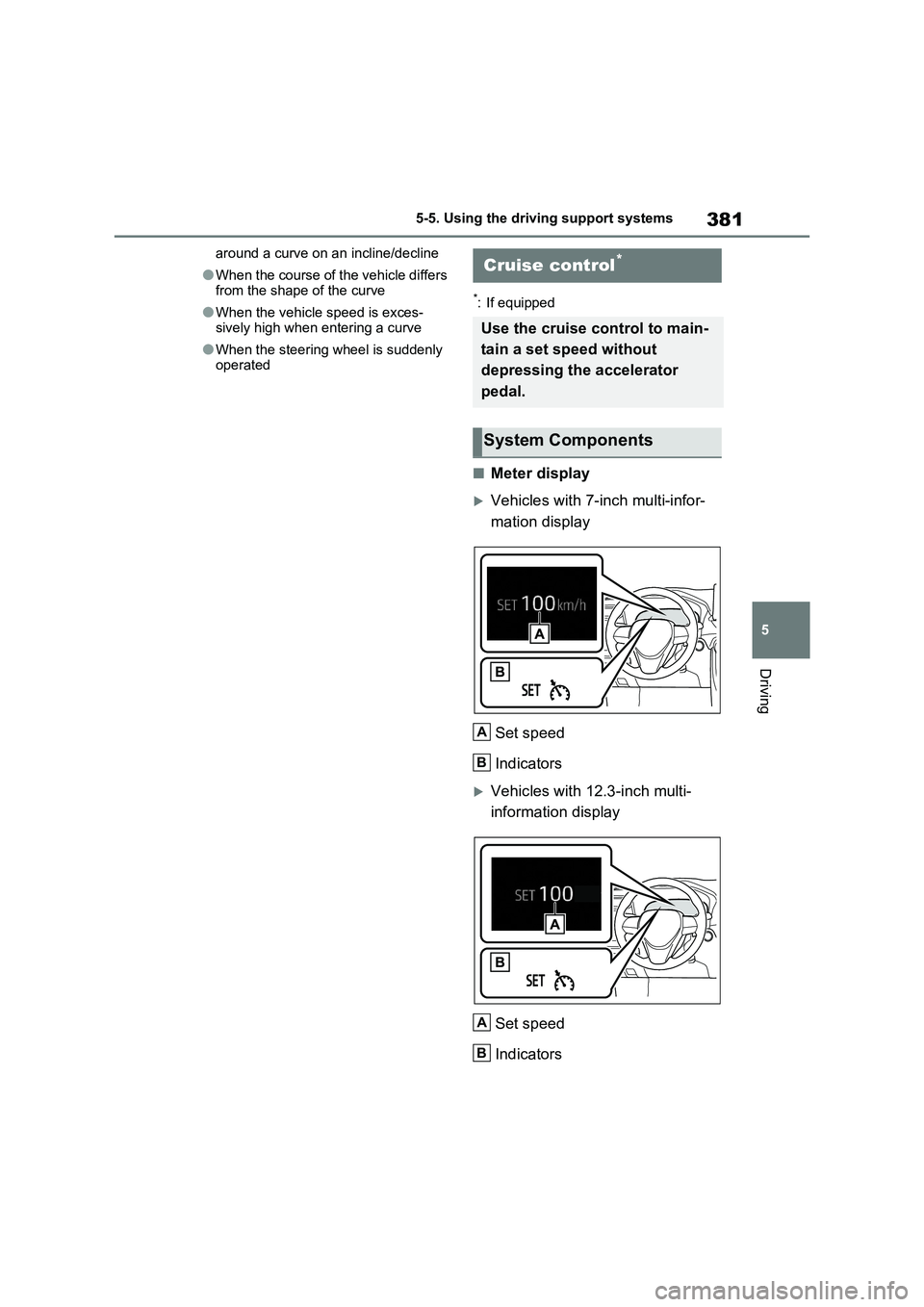
381
5 5-5. Using the driving support systems
Driving
around a curve on an incline/decline
●When the course of the vehicle differs
from the shape of the curve
●When the vehicle speed is exces-
sively high when entering a curve
●When the steering wheel is suddenly
operated
*: If equipped
■Meter display
Vehicles with 7-inch multi-infor-
mation display
Set speed
Indicators
Vehicles with 12.3-inch multi-
information display
Set speed
Indicators
Cruise control*
Use the cruise control to main-
tain a set speed without
depressing the accelerator
pedal.
System Components
A
B
A
B
Page 384 of 718
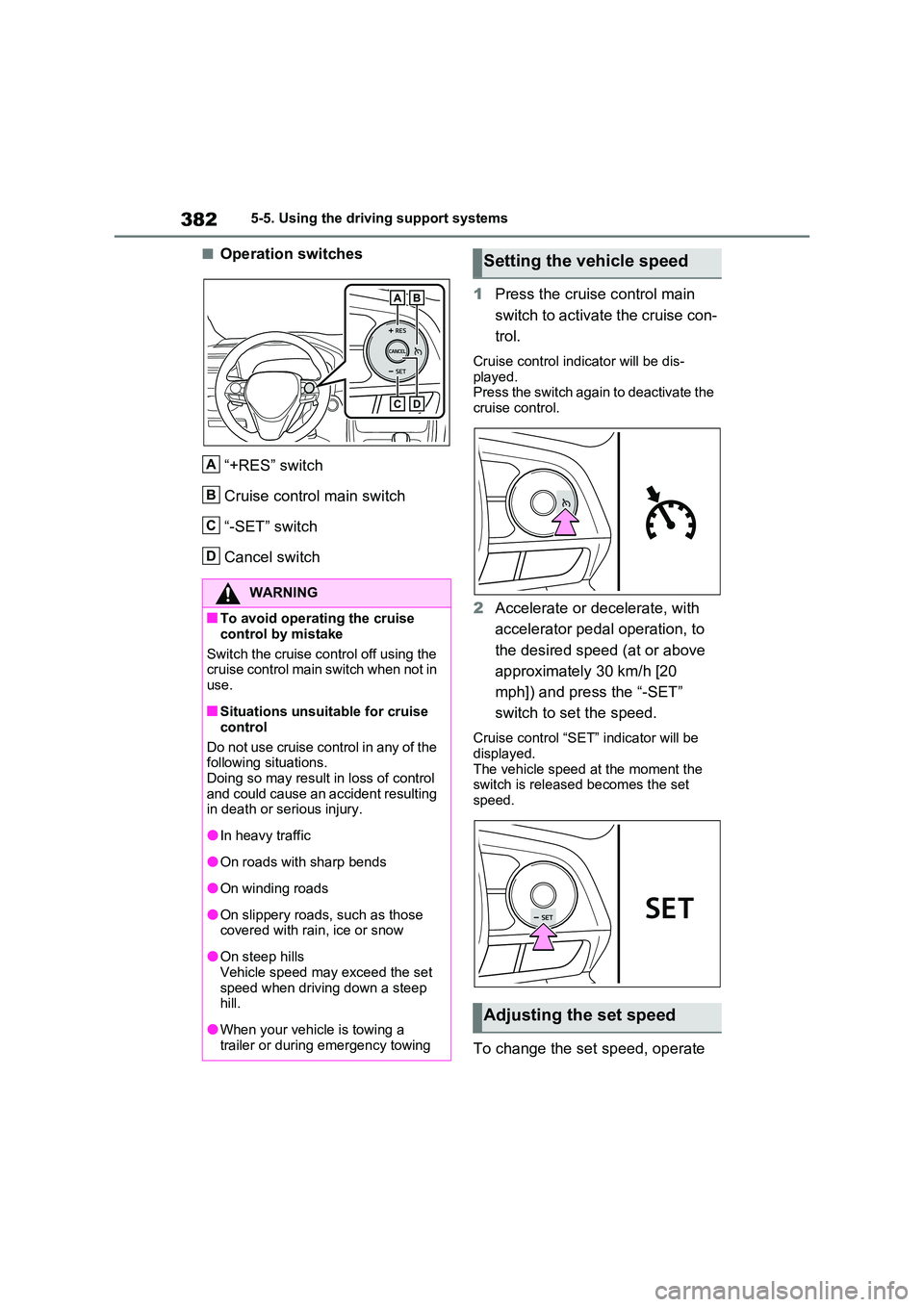
3825-5. Using the driving support systems
■Operation switches
“+RES” switch
Cruise control main switch
“-SET” switch
Cancel switch
1 Press the cruise control main
switch to activate the cruise con-
trol.
Cruise control indicator will be dis-
played. Press the switch again to deactivate the cruise control.
2 Accelerate or decelerate, with
accelerator pedal operation, to
the desired speed (at or above
approximately 30 km/h [20
mph]) and press the “-SET”
switch to set the speed.
Cruise control “SET” indicator will be displayed.
The vehicle speed at the moment the switch is released becomes the set speed.
To change the set speed, operate
WARNING
■To avoid operating the cruise
control by mistake
Switch the cruise control off using the cruise control main switch when not in
use.
■Situations unsuitable for cruise
control
Do not use cruise control in any of the following situations.
Doing so may result in loss of control and could cause an accident resulting in death or serious injury.
●In heavy traffic
●On roads with sharp bends
●On winding roads
●On slippery roads, such as those covered with rain, ice or snow
●On steep hillsVehicle speed may exceed the set
speed when driving down a steep hill.
●When your vehicle is towing a trailer or during emergency towing
A
B
C
D
Setting the vehicle speed
Adjusting the set speed
Page 385 of 718
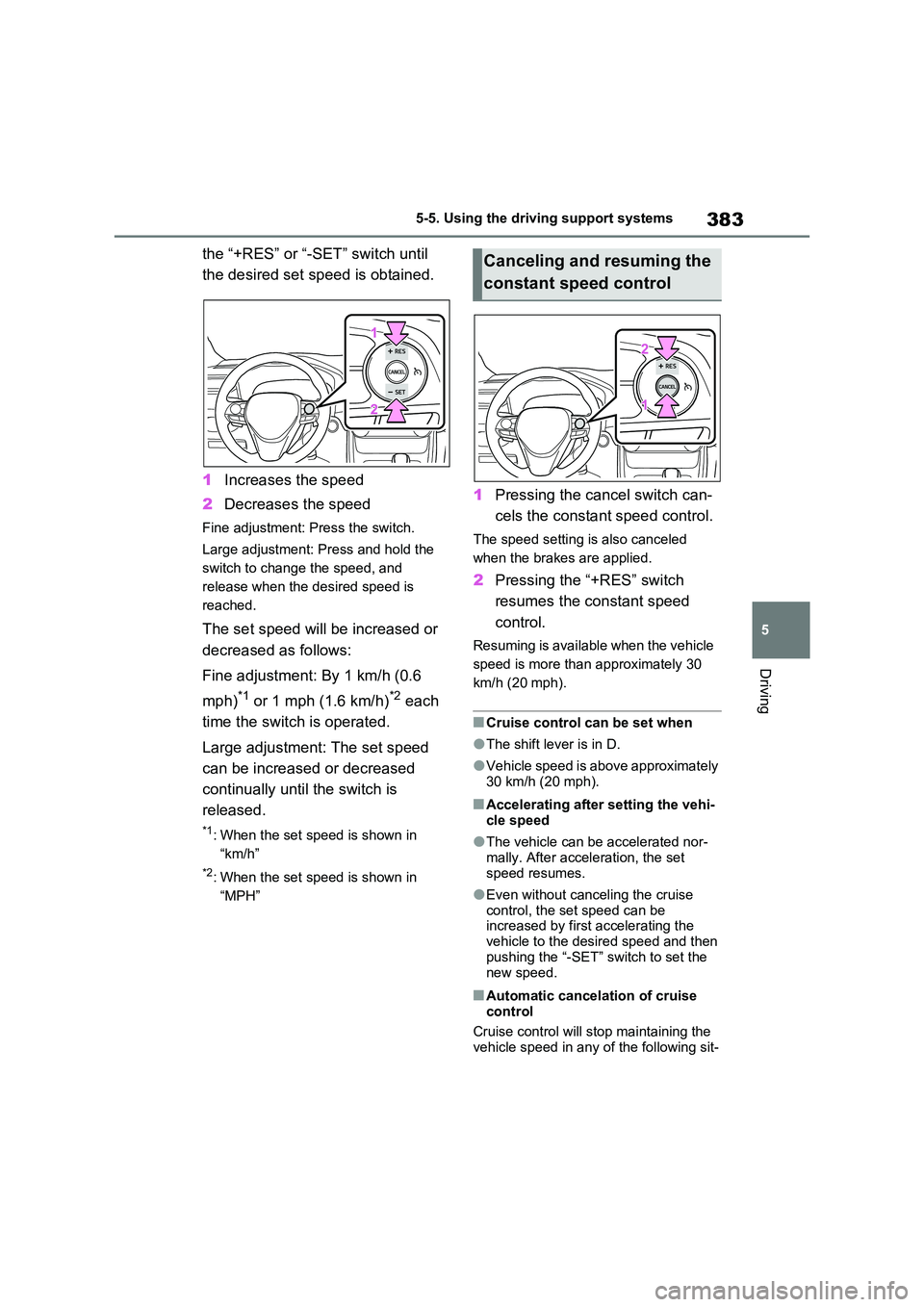
383
5
5-5. Using the driving support systems
Driving
the “+RES” or “-SET” switch until
the desired set speed is obtained.
1 Increases the speed
2 Decreases the speed
Fine adjustment: Press the switch.
Large adjustment: Press and hold the
switch to change the speed, and
release when the desired speed is
reached.
The set speed will be increased or
decreased as follows:
Fine adjustment: By 1 km/h (0.6
mph)*1 or 1 mph (1.6 km/h)*2 each
time the switch is operated.
Large adjustment: The set speed
can be increased or decreased
continually until the switch is
released.
*1: When the set speed is shown in
“km/h”
*2: When the set speed is shown in
“MPH”
1 Pressing the cancel switch can-
cels the constant speed control.
The speed setting is also canceled
when the brakes are applied.
2 Pressing the “+RES” switch
resumes the constant speed
control.
Resuming is available when the vehicle
speed is more than approximately 30
km/h (20 mph).
■Cruise control can be set when
●The shift lever is in D.
●Vehicle speed is above approximately 30 km/h (20 mph).
■Accelerating after setting the vehi-
cle speed
●The vehicle can be accelerated nor-
mally. After acceleration, the set speed resumes.
●Even without canceling the cruise control, the set speed can be increased by first accelerating the
vehicle to the desired speed and then pushing the “-SET” switch to set the
new speed.
■Automatic cancelation of cruise control
Cruise control will stop maintaining the
vehicle speed in any of the following sit-
Canceling and resuming the
constant speed control
Page 386 of 718
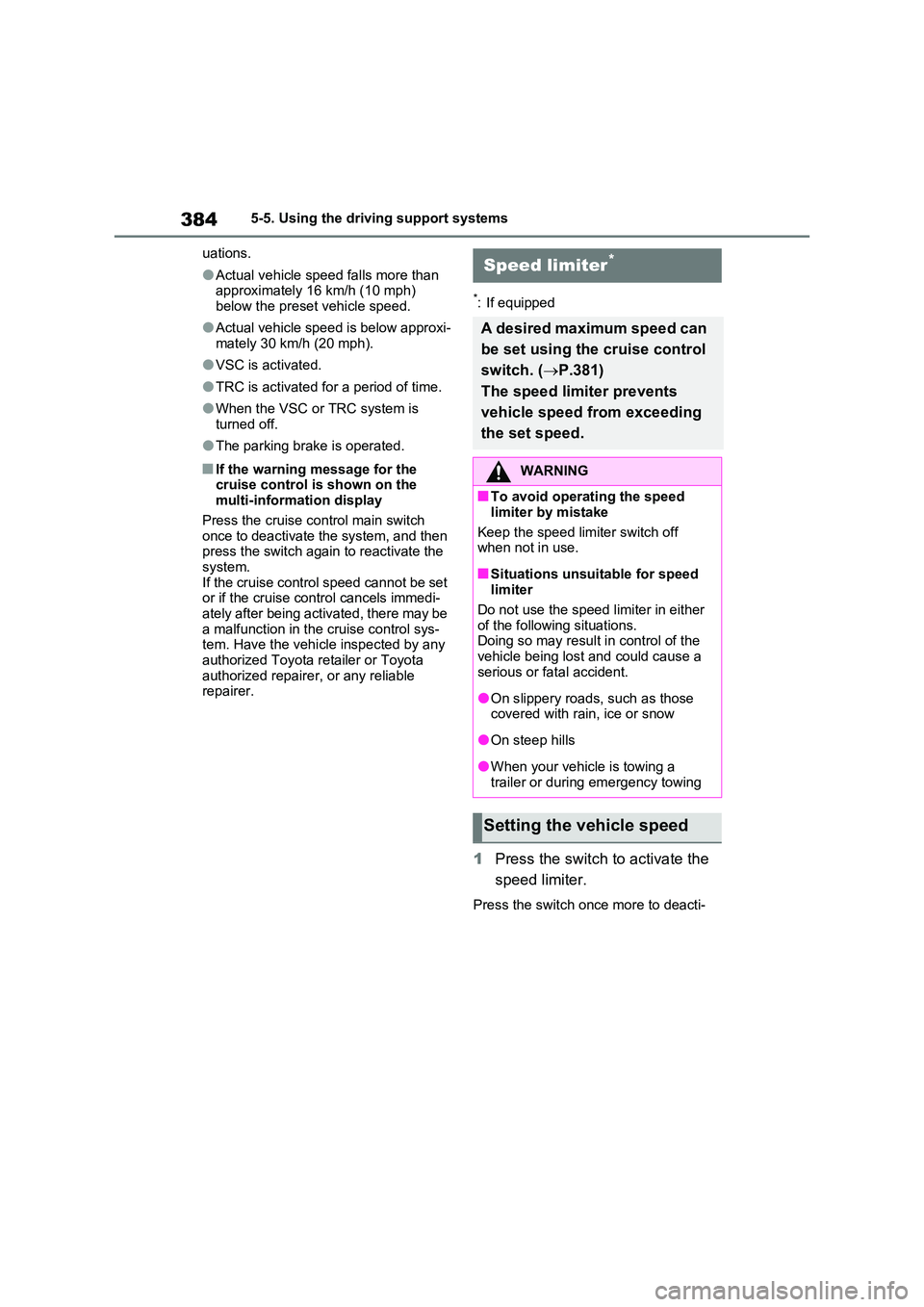
3845-5. Using the driving support systems
uations.
●Actual vehicle speed falls more than approximately 16 km/h (10 mph)
below the preset vehicle speed.
●Actual vehicle speed is below approxi-
mately 30 km/h (20 mph).
●VSC is activated.
●TRC is activated for a period of time.
●When the VSC or TRC system is turned off.
●The parking brake is operated.
■If the warning message for the cruise control is shown on the multi-information display
Press the cruise control main switch once to deactivate the system, and then press the switch again to reactivate the
system. If the cruise control speed cannot be set or if the cruise control cancels immedi-
ately after being activated, there may be a malfunction in the cruise control sys-tem. Have the vehicle inspected by any
authorized Toyota retailer or Toyota authorized repairer, or any reliable repairer.
*: If equipped
1 Press the switch to activate the
speed limiter.
Press the switch once more to deacti-
Speed limiter*
A desired maximum speed can
be set using the cruise control
switch. ( P.381)
The speed limiter prevents
vehicle speed from exceeding
the set speed.
WARNING
■To avoid operating the speed
limiter by mistake
Keep the speed limiter switch off when not in use.
■Situations unsuitable for speed limiter
Do not use the speed limiter in either of the following situations. Doing so may result in control of the
vehicle being lost and could cause a serious or fatal accident.
●On slippery roads, such as those covered with rain, ice or snow
●On steep hills
●When your vehicle is towing a
trailer or during emergency towing
Setting the vehicle speed
Page 387 of 718
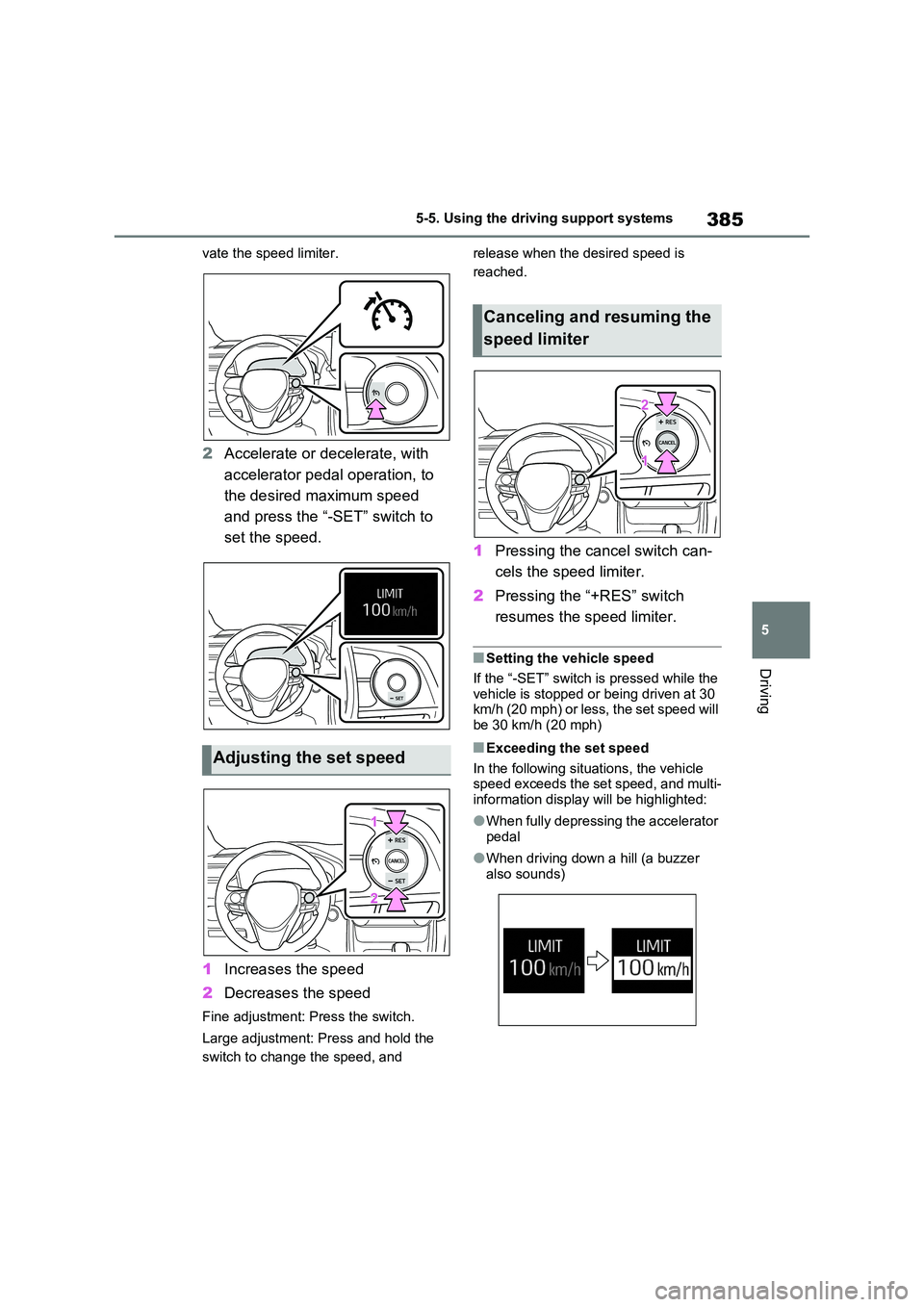
385
5
5-5. Using the driving support systems
Driving
vate the speed limiter.
2 Accelerate or decelerate, with
accelerator pedal operation, to
the desired maximum speed
and press the “-SET” switch to
set the speed.
1 Increases the speed
2 Decreases the speed
Fine adjustment: Press the switch.
Large adjustment: Press and hold the
switch to change the speed, and
release when the desired speed is
reached.
1 Pressing the cancel switch can-
cels the speed limiter.
2 Pressing the “+RES” switch
resumes the speed limiter.
■Setting the vehicle speed
If the “-SET” switch is pressed while the
vehicle is stopped or being driven at 30 km/h (20 mph) or less, the set speed will be 30 km/h (20 mph)
■Exceeding the set speed
In the following situations, the vehicle speed exceeds the set speed, and multi-information display will be highlighted:
●When fully depressing the accelerator pedal
●When driving down a hill (a buzzer also sounds)
Adjusting the set speed
Canceling and resuming the
speed limiter
Page 388 of 718
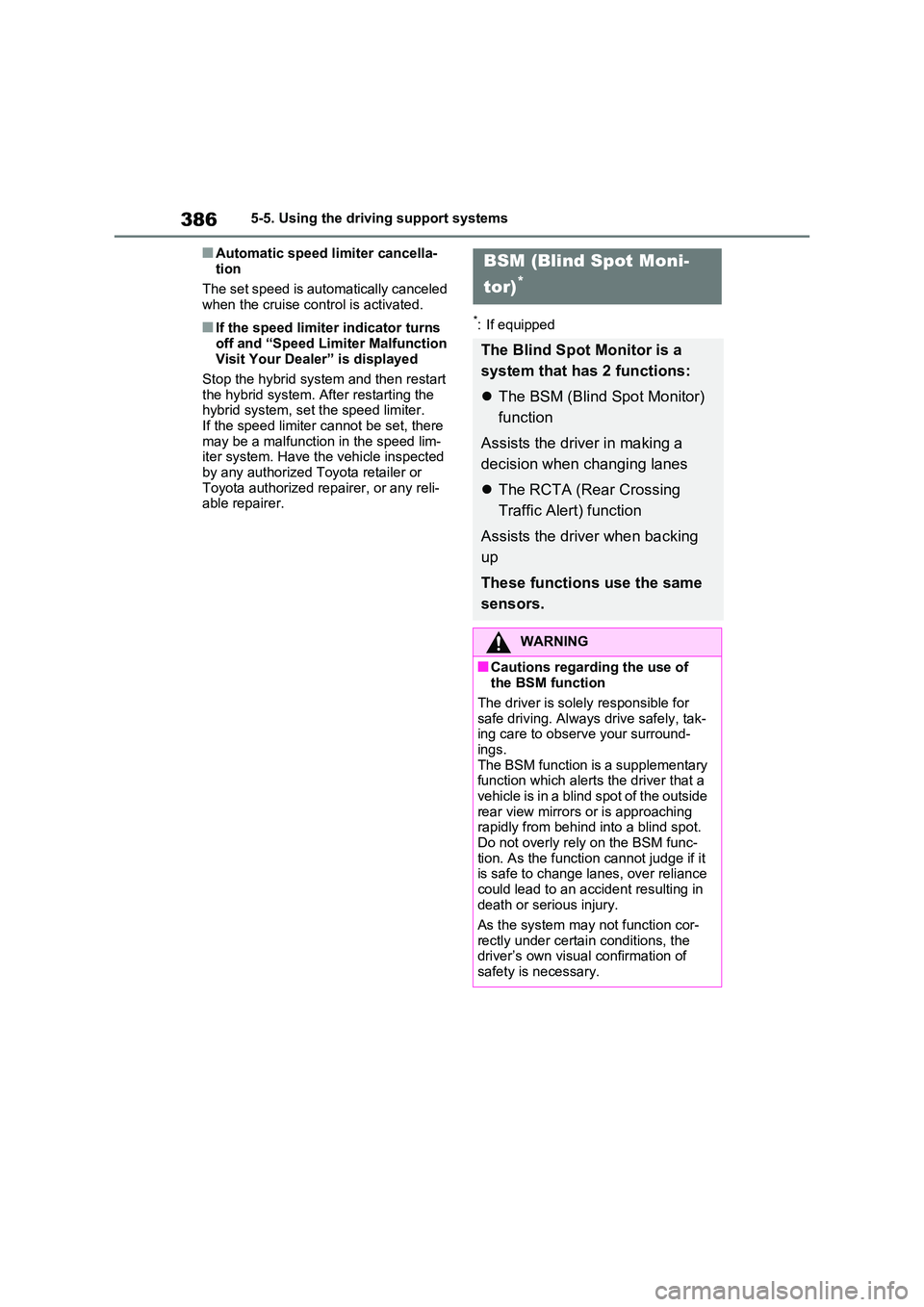
3865-5. Using the driving support systems
■Automatic speed limiter cancella-
tion
The set speed is automatically canceled when the cruise control is activated.
■If the speed limiter indicator turns
off and “Speed Limiter Malfunction Visit Your Dealer” is displayed
Stop the hybrid system and then restart
the hybrid system. After restarting the hybrid system, set the speed limiter.If the speed limiter cannot be set, there
may be a malfunction in the speed lim- iter system. Have the vehicle inspected by any authorized Toyota retailer or
Toyota authorized repairer, or any reli- able repairer.
*: If equipped
BSM (Blind Spot Moni-
tor)*
The Blind Spot Monitor is a
system that has 2 functions:
The BSM (Blind Spot Monitor)
function
Assists the driver in making a
decision when changing lanes
The RCTA (Rear Crossing
Traffic Alert) function
Assists the driver when backing
up
These functions use the same
sensors.
WARNING
■Cautions regarding the use of the BSM function
The driver is solely responsible for safe driving. Always drive safely, tak-ing care to observe your surround-
ings. The BSM function is a supplementary function which alerts the driver that a
vehicle is in a blind spot of the outside rear view mirrors or is approaching rapidly from behind into a blind spot.
Do not overly rely on the BSM func- tion. As the function cannot judge if it is safe to change lanes, over reliance
could lead to an accident resulting in death or serious injury.
As the system may not function cor-
rectly under certain conditions, the driver’s own visual confirmation of safety is necessary.
Page 389 of 718
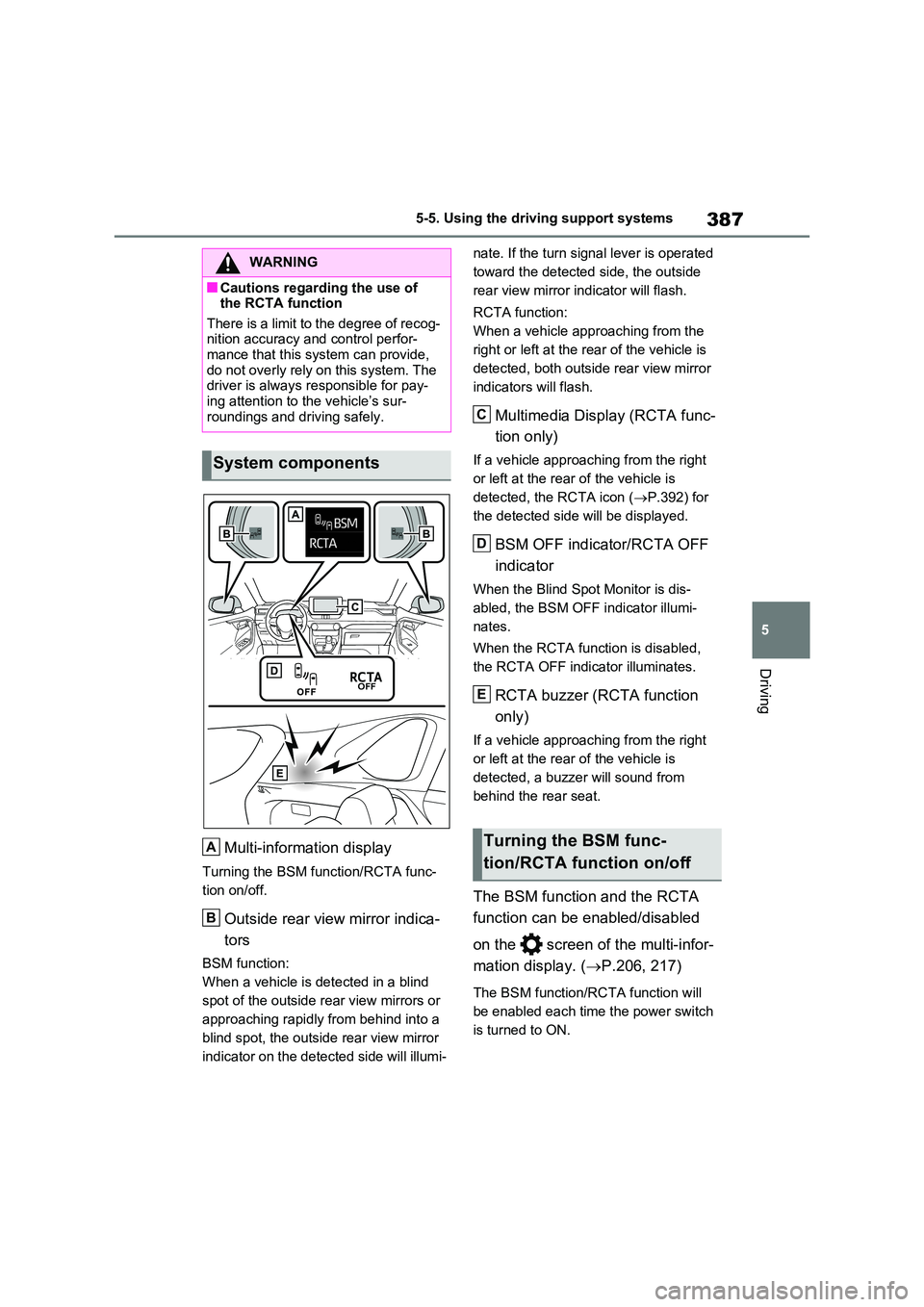
387
5
5-5. Using the driving support systems
Driving
Multi-information display
Turning the BSM function/RCTA func-
tion on/off.
Outside rear view mirror indica-
tors
BSM function:
When a vehicle is detected in a blind
spot of the outside rear view mirrors or
approaching rapidly from behind into a
blind spot, the outside rear view mirror
indicator on the detected side will illumi-
nate. If the turn signal lever is operated
toward the detected side, the outside
rear view mirror indicator will flash.
RCTA function:
When a vehicle approaching from the
right or left at the rear of the vehicle is
detected, both outside rear view mirror
indicators will flash.
Multimedia Display (RCTA func-
tion only)
If a vehicle approaching from the right
or left at the rear of the vehicle is
detected, the RCTA icon ( P.392) for
the detected side will be displayed.
BSM OFF indicator/RCTA OFF
indicator
When the Blind Spot Monitor is dis-
abled, the BSM OFF indicator illumi-
nates.
When the RCTA function is disabled,
the RCTA OFF indicator illuminates.
RCTA buzzer (RCTA function
only)
If a vehicle approaching from the right
or left at the rear of the vehicle is
detected, a buzzer will sound from
behind the rear seat.
The BSM function and the RCTA
function can be enabled/disabled
on the screen of the multi-infor-
mation display. ( P.206, 217)
The BSM function/RCTA function will
be enabled each time the power switch
is turned to ON.
WARNING
■Cautions regarding the use of the RCTA function
There is a limit to the degree of recog- nition accuracy and control perfor-mance that this system can provide,
do not overly rely on this system. The driver is always responsible for pay-ing attention to the vehicle’s sur-
roundings and driving safely.
System components
A
B
Turning the BSM func-
tion/RCTA function on/off
C
D
E
Page 390 of 718
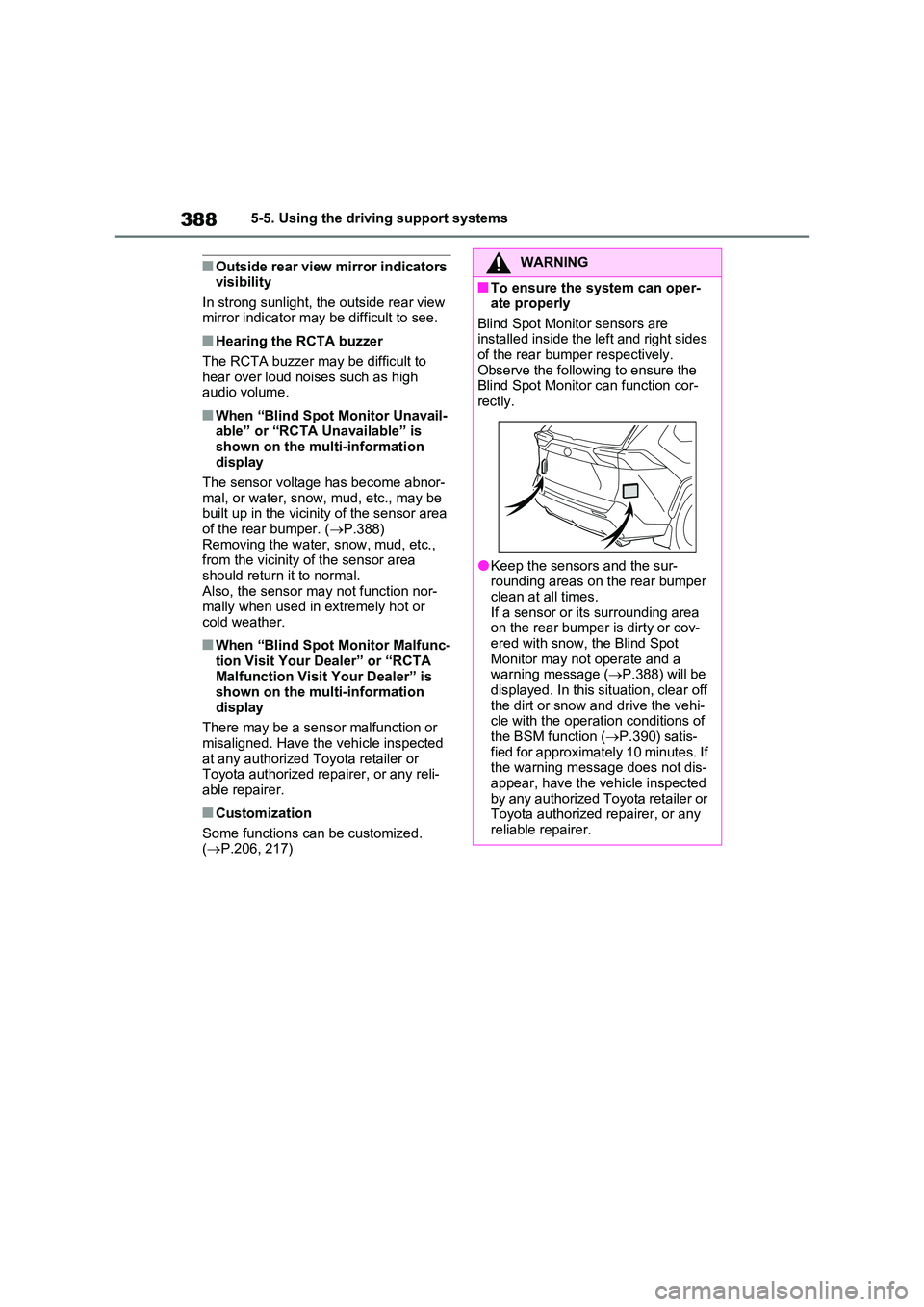
3885-5. Using the driving support systems
■Outside rear view mirror indicators visibility
In strong sunlight, the outside rear view mirror indicator may be difficult to see.
■Hearing the RCTA buzzer
The RCTA buzzer may be difficult to
hear over loud noises such as high audio volume.
■When “Blind Spot Monitor Unavail-able” or “RCTA Unavailable” is
shown on the multi-information display
The sensor voltage has become abnor-
mal, or water, snow, mud, etc., may be built up in the vicinity of the sensor area of the rear bumper. ( P.388)
Removing the water, snow, mud, etc., from the vicinity of the sensor area should return it to normal.
Also, the sensor may not function nor- mally when used in extremely hot or cold weather.
■When “Blind Spot Monitor Malfunc-
tion Visit Your Dealer” or “RCTA Malfunction Visit Your Dealer” is shown on the multi-information
display
There may be a sensor malfunction or misaligned. Have the vehicle inspected
at any authorized Toyota retailer or Toyota authorized repairer, or any reli-
able repairer.
■Customization
Some functions can be customized. ( P.206, 217)
WARNING
■To ensure the system can oper- ate properly
Blind Spot Monitor sensors are installed inside the left and right sides of the rear bumper respectively.
Observe the following to ensure the Blind Spot Monitor can function cor-rectly.
●Keep the sensors and the sur-rounding areas on the rear bumper
clean at all times. If a sensor or its surrounding area on the rear bumper is dirty or cov-
ered with snow, the Blind Spot Monitor may not operate and a warning message ( P.388) will be
displayed. In this situation, clear off the dirt or snow and drive the vehi-cle with the operation conditions of
the BSM function ( P.390) satis- fied for approximately 10 minutes. If the warning message does not dis-
appear, have the vehicle inspected by any authorized Toyota retailer or Toyota authorized repairer, or any
reliable repairer.